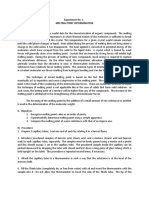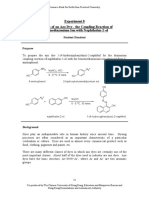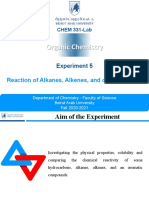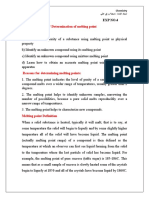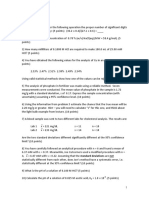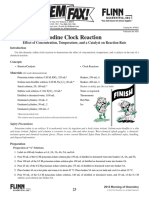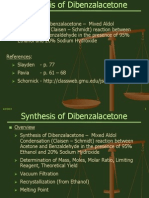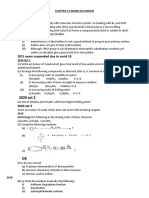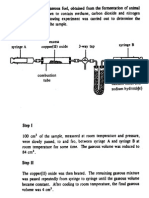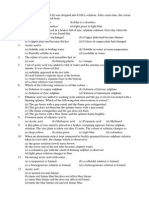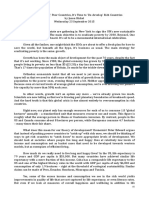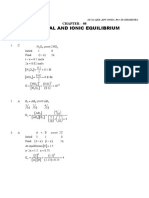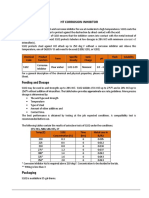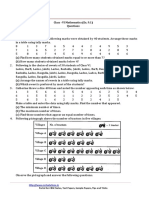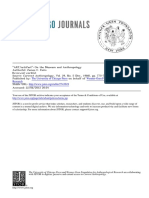Niels stergaard Hammer20103576
Kristian Mark Jacobsen
20107504
Synthesis Report #41 - Part 1
- A Claisen-Schmidt Condensation
The purpose of experiment #41 part 1 was to synthesize E-4-phenylbut-3-en-2-one
(benzylideneacetone) by using the Claisen-Schmidt Condensation reaction. The
reaction scheme in part 1 of the exercise can be seen below:
Figure 1: Reaction scheme
Experimental procedure
Table 1: Amounts and equivalents used in Ex. 41
c (mol/L)
Benzaldehy
de
Acetone
NaOH
2,5
V (mL)
m (g)
8,40
(g/mol)
106,12
12,7
2,0
n (mol)
Eq.
7,92 102
58,08
2,19 101
2,77
39,997
5 103
0,063
Initially benzaldehyde (8,40 g, 1 eq., 79,2 mmol) and acetone (12,7 g, 2,77 eq., 5
mmol) were weighed into a 100 mL round-bottomed flask. The solution was made
basic by adding NaOH (2 mL, 2,5 M) using a syringe. The reaction mixture was left on
a magnetic stirrer and heated to
40 C with an oil bath. The reaction mixture were
left on the stirrer for 90 minutes. After 25 minutes the solution had changed color to
Page 1 of 8
�Niels stergaard Hammer20103576
Kristian Mark Jacobsen
20107504
clear yellow. A division of the solution in a yellow oil phase and a water phase is
observed after 1 hour. A TLC analysis was performed to examine how the reactions
progress. This was done with 9:1 pentane/diethyl ether as eluent due to the products
nonpolar nature. The amount of benzaldehyde used as a reference sample was too
high, so the results were inconclusive. After a total reaction time of 120 minutes
another TLC analysis was performed, with the exact same eluent. For reasons just
described benzaldehyde was diluted in pentane but nevertheless the concentration
was still too high. Even though, the TLC showed rather conclusive results, showing that
the reaction was done (see figure 2).
Figure 2: TLC performed after 120 minutes
The still yellow solution was devided in an oil phase and a water phase as before. To
remove the remaining alkaline residues diluted hydrochloric acid (1M, 5 mL) was now
added to the solution, until it was just acidic on pH-paper. On addition of HCl the
solution changed color into a lighter yellow.
At this point the next step would be to separate the two phases in a separatory funnel.
During this process, the separatory funnel broke in half and the solution was spilled. In
an attempt to recover the wanted oil phase everything was collected with tissues. The
oil phase was now extracted from the tissues with large amounts of diethyl ether. The
diethyl ether was removed on the rotary evaporator.
The solution was dried over MgSO4 to remove any remaining water and then filtered
with suction to obtain the anhydrous solution. The water phase is now believed to be
of minimal size in spite of the accident. The solvent is removed on the rotary
evaporator. A distillation under vacuum was performed to obtain the fraction distilling
at 130-145C. The wanted fraction was transferred to a beaker with a known mass.
Crystallization was achieved by scratching the walls of the beaker with a glass rod,
while cooling with ice water.
Page 2 of 8
�Niels stergaard Hammer20103576
Kristian Mark Jacobsen
20107504
After measuring the mass of the dried crystals an analysis of its melting point was
performed (see results). A small portion (approx. 1,6g) was recrystallized in which the
suspected impure product is dissolved in as little solvent (pentane) as possible during
reflux. The recrystallized product was washed in cold pentane under suction filtration.
This resulted in harder but still light yellow crystals. The crystals were left on filter
paper to dry and later used for melting point analysis, IR spectroscopy and NMR
analysis. The final yield was 3,29 g.
Reaction mechanism
A Claisen-Schmidt condensation reaction is a nucleophilic attack onto a carbonyl
without a -Hydrogen with an enolate derived from deprotonation of a ketone, in this
case acetone. This is followed by an E1cB elimination of water where the leaving group
(atypically eliminations) can be a hydroxide-ion, creating a conjugated carbonyl group.
Page 3 of 8
�Niels stergaard Hammer20103576
Kristian Mark Jacobsen
20107504
Figure 3: Reaction mechanism
Possible side reactions
A possible side reaction is the reaction between benzylideneacetone and an additional
benzaldehyde molecule. This reaction is statistically unfavorable due to the
equivalents chosen in table 1. The possibility of a benzylideneacetone molecule
reacting with benzaldehyde is very low but not unrealistic.
Page 4 of 8
�Niels stergaard Hammer20103576
Kristian Mark Jacobsen
20107504
Figure 4: Side reaction (benzylideneacetone with benzaldehyde)
A plausible side reaction is the self-condensation of acetone to mesityl oxide. Mesityl
oxide is in a liquid state between -53
to 129 C
and is nonpolar, but since the
product is isolated through fraction distilling at 130-145C, the pollution is very likely
to be boiled off into the waste-fraction. Being nonpolar the remaining pollution will
decrease when washed in cold pentane under suction filtration.
Page 5 of 8
�Niels stergaard Hammer20103576
Kristian Mark Jacobsen
20107504
Overall these two side reactions both seem possible. As mentioned above the first
reaction is statistically unrealistic due to the reagent equivalents chosen. The latter
reaction hasnt happened because it statistically is more plausible that an additional
acetone will enolize, because acetone is in large excess compared to
benzylideneacetone.
Results
Yield:
The product was placed in a beaker with known mass (41,0 g) and the mass of the
beaker and product was measured to 44,3 g. This results in a yield of 3,29 g. The
theoretical yield is 11,6 g. This corresponds to a mass% of 28,4 %. The low yield is due
to the accident with the separatory funnel, where a large amount of the product was
lost.
Melting point
The results from the analysis of the melting point are shown in the table below:
Table 2: Melting points
Melting point
interval
Page 6 of 8
�Niels stergaard Hammer20103576
Kristian Mark Jacobsen
20107504
35-37 C
Target
temperature1
Before
recrystallization
After
recrystallization
35-37,9 C
34,2-37 C
IR-spectroscopy
The IR-spectrum was analyzed in the following manner:
max (neat), 3062 (weak/medium, C-H stretch Aryl-H or alkene-H). 3001
IR,
(weak/medium, C-H stretch Aryl-H or alkene-H), 1678 (strong, C=O stretch -
, -
unsaturated ketone), 1602 + 1574+ 1495 (strong, C=C stretch Aryl), 982 (strong, CH bending trans R-HC=CH-R) cm -1.
1
H-NMR spectroscopy
Figure 5: Benzylideneacetone with atom numbers
1
H -NMR (400 MHz,
CDC l 3 )
Hz,
H 13 ), 7,40 (m, 3H,
2H,
H 14+ H 18 ).
(ppm) 2,39 (s, 3H,
H 1 ), 6,72 (d, 1H, J=16,3
H 15+ H 16 + H 17 ), 7,52 (d, 1H, J=16,1 Hz,
1 T. Ken, S. Takeaki, H. Masao,
Eur.J.Org.Chem.,
2007, 16, 2687
Page 7 of 8
H 12 ), 7,55 (m,
�Niels stergaard Hammer20103576
Kristian Mark Jacobsen
The doublet at
20107504
7,52 ppm is disturbed by the multiplet from
7,55 ppm. The
most intense peak in the multiplet is chosen as the second peak in the doublet.
The coupling constant J=16,3 Hz and J=16,1 Hz corresponds to a trans configuration of
the hydrogens at the C=C double bond.
The sum of the integrals are 9,59 (10 when normalized), which matches the 10
hydrogen atoms in benzylideneacetone.
Conclusion
The IR-spectrum shows the expected main groups of the target molecule, and the 1HNMR-spectrum was able to support this result. The melting point of the recrystallized
product is quite close to the reference. Therefore it can be concluded that the
synthesized product is indeed benzylideneacetone in a satisfyingly pure form.
Page 8 of 8












